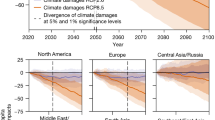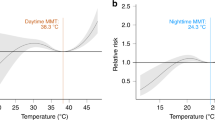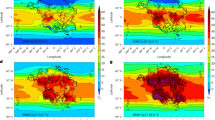Abstract
Extremes of weather and climate can have devastating effects on human society and the environment1,2. Understanding past changes in the characteristics of such events, including recent increases in the intensity of heavy precipitation events over a large part of the Northern Hemisphere land area3,4,5, is critical for reliable projections of future changes. Given that atmospheric water-holding capacity is expected to increase roughly exponentially with temperature—and that atmospheric water content is increasing in accord with this theoretical expectation6,7,8,9,10,11—it has been suggested that human-influenced global warming may be partly responsible for increases in heavy precipitation3,5,7. Because of the limited availability of daily observations, however, most previous studies have examined only the potential detectability of changes in extreme precipitation through model–model comparisons12,13,14,15. Here we show that human-induced increases in greenhouse gases have contributed to the observed intensification of heavy precipitation events found over approximately two-thirds of data-covered parts of Northern Hemisphere land areas. These results are based on a comparison of observed and multi-model simulated changes in extreme precipitation over the latter half of the twentieth century analysed with an optimal fingerprinting technique. Changes in extreme precipitation projected by models, and thus the impacts of future changes in extreme precipitation, may be underestimated because models seem to underestimate the observed increase in heavy precipitation with warming16.
This is a preview of subscription content, access via your institution
Access options
Subscribe to this journal
Receive 51 print issues and online access
$199.00 per year
only $3.90 per issue
Buy this article
- Purchase on Springer Link
- Instant access to full article PDF
Prices may be subject to local taxes which are calculated during checkout



Similar content being viewed by others
References
Parry, M. L., Canziani, O. F., Palutikof, J. P., van der Linden, P. J. & Hanson, C. E. (eds) Climate Change 2007: Impacts, Adaptation and Vulnerability (Cambridge Univ. Press, 2007)
Peterson, T. C. et al. in Weather and Climate Extremes in a Changing Climate. Regions of Focus: North America, Hawaii, Caribbean, and U.S. Pacific Islands (eds Karl, T. R. et al.) 11–34 (Synthesis and Assessment Product 3.3, US Climate Change Science Program, Washington DC, 2008)
Groisman, P. & Ya et al. Trends in intense precipitation in the climate record. J. Clim. 18, 1326–1350 (2005)
Alexander, L. V. et al. Global observed changes in daily climatic extremes of temperature and precipitation. J. Geophys. Res. 111 D05109 10.1029/2005JD006290 (2006)
Trenberth, K. E. et al. in Climate Change 2007: The Physical Science Basis (eds Solomon, S. et al.) 235–336 (Cambridge Univ. Press, 2007)
Allen, M. R. & Ingram, W. J. Constraints on future changes in climate and the hydrologic cycle. Nature 419, 224–232 (2002)
Trenberth, K. E., Dai, A., Rasmussen, R. M. & Parsons, D. B. The changing character of precipitation. Bull. Am. Meteorol. Soc. 84, 1205–1217 (2003)
Wentz, F. J. & Schabel, M. Precise climate monitoring using complementary satellite data sets. Nature 403, 414–416 (2000)
Pall, P., Allen, M. R. & Stone, D. A. Testing the Clausius-Clapeyron constraint on changes in extreme precipitation under CO2 warming. Clim. Dyn. 28, 351–363 (2007)
Santer, B. D. et al. Identification of human-induced changes in atmospheric moisture content. Proc. Natl Acad. Sci. USA 104, 15248–15253 (2007)
Willett, K. M., Gillett, N. P., Jones, P. D. & Thorne, P. W. Attribution of observed surface humidity changes to human influence. Nature 449, 710–712 (2007)
Hegerl, G. C., Zwiers, F. W., Stott, P. A. & Kharin, V. V. Detectability of anthropogenic changes in annual temperature and precipitation extremes. J. Clim. 17, 3683–3700 (2004)
Hegerl, G. C. et al. in Climate Change 2007: The Physical Science Basis (eds Solomon, S. et al.) 663–745 (Cambridge Univ. Press, 2007)
Kiktev, D., Caesar, J., Alexander, L. V., Shiogama, H. & Collier, M. Comparison of observed and multimodeled trends in annual extremes of temperature and precipitation. Geophys. Res. Lett. 34 L10702 10.1029/2007GL029539 (2007)
Min, S.-K., Zhang, X. B., Zwiers, F. W., Friederichs, P. & Hense, A. Signal detectability in extreme precipitation changes assessed from twentieth century climate simulations. Clim. Dyn. 32, 95–111 (2009)
Allan, R. P. & Soden, B. J. Atmospheric warming and the amplification of precipitation extremes. Science 321, 1481–1484 (2008)
Tebaldi, C., Hayhoe, K., Arblaster, J. M. & Meehl, G. A. Going to the extremes: an intercomparison of model-simulated historical and future changes in extreme events. Clim. Change 79, 185–211 (2006)
Kharin, V. V., Zwiers, F. W., Zhang, X. & Hegerl, G. C. Changes in temperature and precipitation extremes in the IPCC ensemble of global coupled model simulations. J. Clim. 20, 1419–1444 (2007)
Zwiers, F. W. & Kharin, V. V. Changes in the extremes of the climate simulated by CCC GCM2 under CO2 doubling. J. Clim. 11, 2200–2222 (1998)
Meehl, G. et al. in Climate Change 2007: The Physical Science Basis (eds Solomon, S. et al.) 747–845 (Cambridge Univ. Press, 2007)
Allen, M. R. & Stott, P. A. Estimating signal amplitudes in optimal fingerprinting. Part I: theory. Clim. Dyn. 21, 477–491 (2003)
Allen, M. R. & Tett, S. F. B. Checking for model consistency in optimal fingerprinting. Clim. Dyn. 15, 419–434 (1999)
Zhang, X. et al. Detection of human influence on 20th century precipitation trends. Nature 448, 461–465 (2007)
Min, S.-K., Zhang, X. & Zwiers, F. Human-induced Arctic moistening. Science 320, 518–520 (2008)
Emori, S. & Brown, S. J. Dynamic and thermodynamic changes in mean and extreme precipitation under changed climate. Geophys. Res. Lett. 32 L17706 10.1029/2005GL023272 (2005)
O’Gorman, P. A. & Schneider, T. The physical basis for increases in precipitation extremes in simulations of 21st-century climate change. Proc. Natl Acad. Sci. USA 106, 14773–14777 (2009)
Sugiyama, M., Shiogama, H. & Emori, S. Precipitation extreme changes exceeding moisture content increases in MIROC and IPCC climate models. Proc. Natl Acad. Sci. USA 107, 571–575 (2010)
Durman, C. F., Gregory, J. M., Hassell, D. C., Jones, R. G. & Murphy, J. M. A comparison of extreme European daily precipitation simulated by a global and a regional climate model for present and future climates. Q. J. R. Meteorol. Soc. 127, 1005–1015 (2001)
Randall, D. A. et al. in Climate Change 2007: The Physical Science Basis (eds Solomon, S. et al.) 589–662 (Cambridge Univ. Press, 2007)
Kharin, V. V. & Zwiers, F. W. Estimating extremes in transient climate change simulations. J. Clim. 18, 1156–1173 (2005)
Acknowledgements
We thank N. Gillett and B. Yu for comments, M. Wehner for provision of CCSM3 data, and J. Penner and M. Sugiyama for discussion. We acknowledge the modelling groups, the Program for Climate Model Diagnosis and Intercomparison (PCMDI) and the World Climate Research Programme’s (WCRP's) Working Group on Coupled Modelling (WGCM) for their roles in making available the WCRP CMIP3 multi-model data set. Support for this data set is provided by the Office of Science, US Department of Energy. We acknowledge the support of the International Detection and Attribution Group (IDAG) by the US Department of Energy’s Office of Science, Office of Biological and Environmental Research and the National Oceanic and Atmospheric Administration’s Climate Program Office. S.-K.M. was supported by the Canadian International Polar Year (IPY) programme. G.C.H. was supported by the NSF (grant ATM-0296007).
Author information
Authors and Affiliations
Contributions
S.-K.M. carried out analysis. X.Z., F.W.Z. and G.C.H. contributed to the analysis. All authors discussed the results and contributed to writing the paper.
Corresponding authors
Ethics declarations
Competing interests
The authors declare no competing financial interests.
Supplementary information
Supplementary Information
This file contains Supplementary Text 1-9, additional references, Supplementary Tables 1-3 and Supplementary Figures 1-17 with legends. (PDF 9096 kb)
Rights and permissions
About this article
Cite this article
Min, SK., Zhang, X., Zwiers, F. et al. Human contribution to more-intense precipitation extremes. Nature 470, 378–381 (2011). https://doi.org/10.1038/nature09763
Received:
Accepted:
Published:
Issue Date:
DOI: https://doi.org/10.1038/nature09763
This article is cited by
-
Increase in MJO predictability under global warming
Nature Climate Change (2024)
-
Anthropogenic aerosols mask increases in US rainfall by greenhouse gases
Nature Communications (2024)
-
Future changes in the precipitation regime over the Arabian Peninsula with special emphasis on UAE: insights from NEX-GDDP CMIP6 model simulations
Scientific Reports (2024)
-
Twenty-five years of Open-Top Chambers in tropical environments: where, how, and what are we looking at regarding flora response to climate change?
Planta (2024)
-
Application of Thermal Imaging for Assessing Desiccation Stress Memory in Sugarcane and Sorghum Cultivars
Sugar Tech (2024)
Comments
By submitting a comment you agree to abide by our Terms and Community Guidelines. If you find something abusive or that does not comply with our terms or guidelines please flag it as inappropriate.



